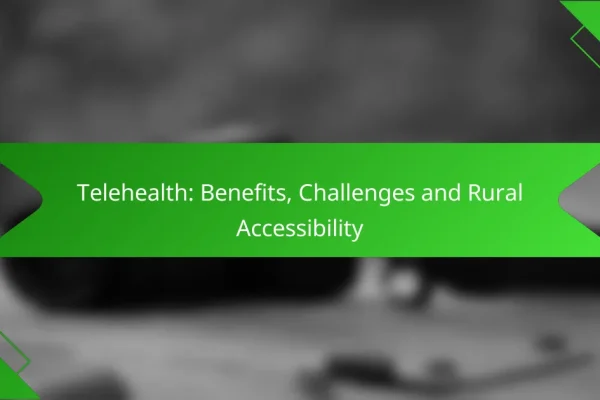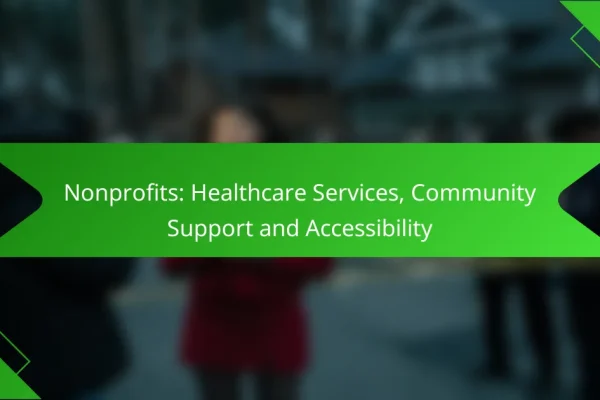How can healthcare access be improved in the US?
Improving healthcare access in the US requires a multi-faceted approach that includes expanding telehealth services, enhancing community health initiatives, and implementing policy reforms for insurance coverage. These strategies aim to reduce barriers and ensure that more individuals can receive the care they need.
Telehealth services expansion
Expanding telehealth services can significantly enhance healthcare access by allowing patients to consult with healthcare providers remotely. This is particularly beneficial for individuals in rural areas or those with mobility issues, as it reduces travel time and associated costs.
Healthcare providers should consider integrating telehealth into their practices by utilizing secure video conferencing tools and ensuring compliance with regulations such as HIPAA. Offering a range of services, from routine check-ups to mental health consultations, can further increase accessibility.
Community health initiatives
Community health initiatives play a crucial role in improving access by addressing local health disparities and promoting preventive care. Programs such as mobile clinics and health fairs can bring services directly to underserved populations.
Collaboration with local organizations can enhance these initiatives. For example, partnerships with schools or community centers can facilitate outreach and education, ensuring that residents are aware of available health resources.
Policy reforms for insurance coverage
Policy reforms aimed at expanding insurance coverage are essential for improving healthcare access. This may involve increasing subsidies for low-income individuals or expanding Medicaid in states that have not yet done so.
Advocates should focus on promoting policies that eliminate coverage gaps and reduce out-of-pocket expenses. Ensuring that insurance plans cover preventive services without cost-sharing can encourage individuals to seek care before health issues escalate.
What are the barriers to healthcare access in the US?
Barriers to healthcare access in the US include high costs, lack of insurance, and geographic disparities. These factors significantly impact individuals’ ability to obtain necessary medical services and can lead to poorer health outcomes.
Cost of healthcare services
The cost of healthcare services in the US is a significant barrier for many individuals. Out-of-pocket expenses for visits, treatments, and medications can be prohibitively high, often leading people to forgo necessary care.
For example, a routine doctor’s visit can range from $100 to $300 without insurance, while emergency care can cost thousands. Patients should consider comparing prices and looking for community health clinics that offer services on a sliding scale based on income.
Lack of insurance coverage
A lack of insurance coverage is a critical barrier to accessing healthcare in the US. Approximately 8-10% of the population remains uninsured, which limits their access to affordable care.
Uninsured individuals often face higher costs for medical services and may delay seeking treatment until conditions worsen. Exploring options through the Health Insurance Marketplace or state Medicaid programs can help individuals find coverage that fits their needs and budget.
Geographic disparities in service availability
Geographic disparities create significant barriers to healthcare access, particularly in rural areas where medical facilities may be scarce. Many rural communities lack hospitals or specialists, forcing residents to travel long distances for care.
In contrast, urban areas typically have more healthcare resources, but they can also face challenges like overcrowding. Telehealth services can help bridge the gap for those in remote locations, allowing patients to consult with healthcare providers without the need for travel.
What role do government programs play in healthcare access?
Government programs significantly enhance healthcare access in the US by providing coverage options for low-income individuals, seniors, and those with disabilities. Programs like Medicaid and Medicare help reduce financial barriers, ensuring that millions of Americans receive necessary medical services.
Medicaid expansion impacts
Medicaid expansion under the Affordable Care Act allows states to extend coverage to more low-income adults, significantly increasing access to healthcare. States that adopted this expansion have seen reductions in uninsured rates, improved health outcomes, and lower hospital costs due to increased preventive care.
For example, states that expanded Medicaid reported coverage increases of around 20-30% among low-income populations. This expansion often leads to better management of chronic conditions and reduced emergency room visits.
Medicare coverage options
Medicare provides health coverage primarily for individuals aged 65 and older, as well as some younger people with disabilities. It consists of different parts: Part A covers hospital insurance, while Part B covers outpatient services, and Part D provides prescription drug coverage.
Beneficiaries can choose between Original Medicare and Medicare Advantage plans. The latter often includes additional benefits like vision and dental care, which can enhance overall access to necessary services.
Affordable Care Act provisions
The Affordable Care Act (ACA) introduced several provisions aimed at improving healthcare access, including the establishment of health insurance marketplaces and the requirement for insurers to cover pre-existing conditions. These measures have made it easier for individuals to obtain affordable coverage.
Additionally, the ACA provides subsidies to help lower-income individuals afford premiums, making healthcare more accessible. This has led to millions gaining insurance, particularly in states that expanded Medicaid.
How does socioeconomic status affect healthcare access?
Socioeconomic status significantly impacts healthcare access by influencing individuals’ ability to afford medical services, insurance coverage, and overall health outcomes. Those with lower socioeconomic status often face barriers that limit their access to necessary healthcare resources.
Income-related access disparities
Income plays a crucial role in determining healthcare access, as individuals with higher incomes typically have better access to quality medical services. For example, people in the low-income bracket may struggle to afford health insurance premiums or out-of-pocket expenses, leading to delayed or foregone medical care.
In the U.S., low-income individuals might rely on government programs like Medicaid, which varies by state in terms of eligibility and coverage. This can create significant disparities in access to care, as some states have more comprehensive programs than others.
Education and health literacy
Education level and health literacy are vital factors influencing healthcare access. Individuals with higher education levels are often more aware of healthcare options and how to navigate the system effectively. They tend to understand medical information better, leading to more informed health decisions.
Conversely, those with lower education levels may struggle to comprehend medical instructions or the importance of preventive care. This lack of understanding can result in missed appointments, improper medication use, and ultimately poorer health outcomes. Community programs aimed at improving health literacy can help bridge this gap.
What are the effects of healthcare access on public health outcomes?
Healthcare access significantly influences public health outcomes by determining the availability and quality of medical services individuals can receive. Improved access leads to better management of diseases, higher rates of preventive care, and overall enhanced community health.
Chronic disease management
Effective chronic disease management relies heavily on accessible healthcare services. Patients with conditions such as diabetes or hypertension benefit from regular check-ups, medication adherence, and lifestyle counseling, which are more achievable when healthcare is readily available.
For instance, individuals with access to healthcare can engage in routine monitoring and receive timely interventions, reducing the risk of complications. Conversely, limited access can lead to poorly managed conditions, resulting in higher healthcare costs and worse health outcomes.
Preventive care utilization
Access to healthcare directly impacts the utilization of preventive care services, such as vaccinations and screenings. When healthcare is accessible, individuals are more likely to participate in preventive measures that can identify health issues early and reduce the incidence of serious diseases.
For example, regular screenings for cancers like breast and cervical cancer can significantly lower mortality rates. Communities with higher healthcare access often see greater participation in these preventive services, leading to healthier populations and reduced long-term healthcare costs.
What are the emerging trends in healthcare access in the US?
Emerging trends in healthcare access in the US include the rise of telehealth services, increased focus on social determinants of health, and the expansion of community health initiatives. These trends aim to improve accessibility, affordability, and quality of care for diverse populations.
Telehealth Services
Telehealth services have gained significant traction, especially following the COVID-19 pandemic. Patients can now consult healthcare providers remotely, which reduces travel time and associated costs. Many insurance plans are expanding coverage for telehealth, making it a more viable option for routine care.
However, access to technology and internet connectivity can be barriers for some populations. It’s essential for healthcare providers to ensure that telehealth platforms are user-friendly and accessible to all patients, including those with limited digital literacy.
Social Determinants of Health
There is a growing recognition of social determinants of health, such as income, education, and housing stability, which significantly impact healthcare access. Programs that address these factors aim to improve overall health outcomes by providing resources and support to underserved communities.
Healthcare organizations are increasingly collaborating with community organizations to create holistic approaches that address both medical and social needs. This trend emphasizes the importance of integrating health services with social support systems.
Community Health Initiatives
Community health initiatives are expanding to provide localized care and support, often focusing on preventive measures. These initiatives may include mobile clinics, health fairs, and partnerships with local organizations to reach vulnerable populations.
Such programs can enhance healthcare access by bringing services directly to communities, reducing barriers related to transportation and cost. Engaging community members in the planning and implementation of these initiatives is crucial for their success and sustainability.










